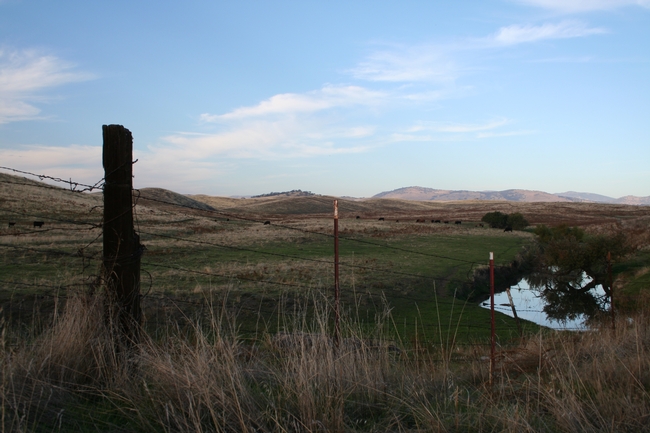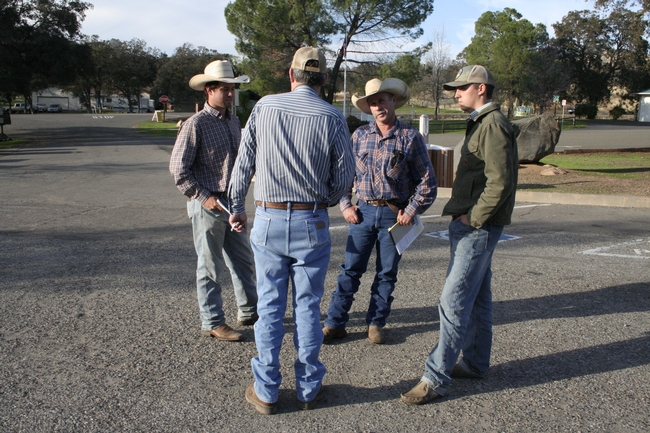Posts Tagged: grass
Grass-fed beef production a possible money-maker for Central California ranchers
The health benefits of grass-fed beef are well documented. Meat from cattle that live out their lives grazing on rangeland before being processed has more beta-carotene, vitamin E and omega-3 fatty acids than the meat from animals finished at feed lots.
The health benefits – and for some consumers, the idea that cattle raised on the range have longer, happier lives than conventional beef cattle – increases the value of the product. Grass-fed beef generally sells for 60 percent more per pound than standard beef. These potential premium prices get cattle ranchers' interest, and therefore captured the attention of UC Cooperative Extension rangeland advisor for Mariposa and Merced counties Fadzayi Mashiri.
Two major challenges face ranchers who wish to produce grass-fed beef: the lack of local processing plants, and the unfamiliar marketing strategies that successfully selling a niche product demands.
“I decided to bring ranchers together to discuss these issues,” Mashiri said. She formed a group that meets regularly in Mariposa County to discuss how they might be able to work as a team to break into the grass-fed beef market. Mashiri sees this project as an opportunity for the ranchers to diversify their sources of income and increase profit margins.
“Farm to fork is getting big,” said Marshall Long, a Mariposa County supervisor and rancher who attended the meeting this fall. “I want to keep those value-added dollars in the county.
Most of the ranchers in the valley and foothill counties of Merced, Mariposa, Madera and Fresno have cow-calf operations. After calves are born on the range, they stay on the land for about a year before being sold at auctions and fed grain or other high-carbohydrate feeds in feedlots. In grass-fed production, yearlings aren't sold, but rather kept on the land for another two years before they are processed.
The meat can be quite different. Grass-fed cattle produce meat with a distinctive flavor, less marbling, and a yellow cast. And, it commands a higher price.
Mashiri invited Tara Schiff, the grant coordinator with the Mariposa County Chamber of Commerce, to the recent grass-fed beef planning meeting. Schiff spearheaded the development of a “Made in Mariposa” marketing brand. The initiative has more than 100 members, including local producers of vegetables, cider and wine.
“We have strength in numbers,” Schiff said.
Made in Mariposa is a potential marketing partner, or represents a model for local beef producers to emulate.
“If we think big, how big do we want to be?” Mashiri asked. “Can we work together to relieve individual producers of the pressure of selling on their own?”
The producers concluded that their next step would be a market study to determine whether stores and restaurants would be willing to pay for a ready supply of grass-fed beef. Schiff of Made in Mariposa and Mashiri will identify grant opportunities that would allow the group to move forward with the study.
Under Mashiri's leadership the ranchers will come together again in the spring to continue their planning work together to increase their businesses' bottom lines by diversifying into the production of a specialty meat product.
Lack of local slaughterhouse enlarges footprint
The efforts of grass-fed beef producers in Northern California to shrink their carbon footprints are frustrated by the need to truck animals long distances to the nearest slaughterhouse, according to an article in today's Santa Rosa Press Democrat.
“There just aren't enough of these smaller plants people can go to,” the article quoted John Harper, UC Cooperative Extension livestock farm advisor in Mendocino County.
The story said Harper is working on a slaughterhouse project with Mendocino County ranchers, community members and economic development officials. They're hoping to attract an investor willing to build one.
Small meat-processing facilities used to be commonplace all over the country, Harper said, but most have disappeared. Ukiah's last slaughterhouse closed almost 50 years ago. Four large corporations now process 85 percent of the nation's cattle, most of which are finished in feedlots eating grain.
To reach remote producers, USDA promotes mobile slaughterhouses. However, Harper told reporter Glenda Anderson that the mobile alternative isn't feasible for Mendocino County. State law makes it illegal to bury the inedible and unusable parts of butchered animals, so the mobile facility presents a disposal problem.
Four years ago, a Marin County investor proposed building a meatpacking facility in the Ukiah Valley, but the plan was dropped because of local opposition. Opponents feared the facility would emit an unpleasant odor, the story said.
“I learned really quickly the public doesn't know the difference between a feedlot and a meat-processing plant,” Harper was quoted.
The facility being promoted would not include a feedlot, which generates the odor people mistakenly associate with slaughterhouses, Harper said. After one study and public outreach, Harper believes that objections to a local slaughterhouse now are limited to people who don't believe animals should be killed for food.

Beef grazing grassland.
Happy cows produce healthy beef
Several studies suggest that grass-fed beef is more nutritious than conventional grain-fed beef, says a research review published in the March 2010 issue of Nutrition Journal.The review, written by three Chico State professors and UC Cooperative Extension livestock advisors Glenn Nader and Stephanie Larson, says the diet of exclusively grass gives beef a higher amount of Vitamin A and E precursors, boosts cancer-fighting antioxidants and reduces overall fat content.
"However, consumers should be aware that the differences in (fatty acid) content will also give grass-fed beef a distinct grass flavor and unique cooking qualities," the researchers wrote
In addition, the fat from grass-finished beef may have a yellowish appearance from the elevated carotenoid content. However, the slight changes in taste and appearance may be well worth getting used to.
Along with improved nutrients and lower fat in grass-fed beef, the product has a healthier lipid profile than its conventional counterpart. Health professionals worldwide recommend reduced consumption of saturated fat, trans fat and cholesterol. Grass-fed beef helps consumers meet the recommendation.
Raising cattle on the range also results in an improved omega-3/omega-6 fatty acid ratio in the beef, the authors said. A healthy diet should consist of roughly one to four times more omega-6 fatty acids than omega-3 fatty acids. However, the typical American diet tends to contain 11 to 30 times more omega-6 than omega -3, a phenomenon that may be a significant factor in the rising rate of inflammatory disorders in the United States.
Cooking grass-fed beef to perfection requires a few adjustments. For example, because it is low in fat, it should be coated with extra virgin olive oil, truffle oil or another light oil to enhance flavor and improve browning. The high protein and low fat levels mean the beef will usually require 30 percent less cooking time.
More cooking instructions plus information about grass-fed beef's health benefits, niche marketing, labeling and cost of production are available on the Grass-Fed Beef Web page, developed by the UC and Chico State researchers who wrote the research review for Nutrition.
PopSci pursues the perfect lawn
Popular Science, the world's largest science and technology magazine, spotlighted the work of UC Riverside Cooperative Extension turf scientist Jim Baird in its May 2010 "Statistically Speaking" feature. Titled "The Perfect Lawn," the full-page story said Baird is bioengineering grass that drinks less water and still earns praise for its lush, emerald green appearance.
"The process is sort of a gladiator academy for grass," PopSci says. The scientists grow promising hybrids, then turn off the water to see which ones survive.
The article opens with statistics on turf grass' ability to sequester carbon. U.S. lawns, it says, could trap enough carbon each year to offset the emissions from burning 1.9 billion gallons of gasoline. However, it takes 7 billion gallons of water a year to keep the grass green.
Other statistics in the feature were:
- 625 square feet - Area of lawn needed to make enough oxygen for one person for one day
- 1.57 billion hours - Time homeowners spend mowing the lawn per year
- 37 billion pounds - Carbon dioxide that residential lawns can store per year
- 800 million gallons - Amount of gas guzzled by lawn mowers annually
- 33,000 square miles - Area of the U.S. covered by residential lawns

Jim Baird
Grass-fed beef fights cancer, study finds
Several studies suggest that eating grass-fed beef elevates precursors for Vitamin A and E, as well as cancer-fighting antioxidants such as glutathione and superoxide dismutase, compared with eating beef from grain-fed animals, says a research review published in the current issue of Nutrition Journal.
The review, written by three Chico State professors and UC Cooperative Extension livestock advisors Glenn Nader and Stephanie Larson, reported that grass-fed beef has an overall lower fat content.
"However, consumers should be aware that the differences in (fatty acid) content will also give grass-fed beef a distinct grass flavor and unique cooking qualities," the researchers wrote.
In addition, the fat from grass-finished beef may have a yellowish appearance from the elevated carotenoid content (precursor to Vitamin A).
The research prompted San Francisco Examiner blogger Joshua Horrocks to ponder whether grass-fed beef is the key to cancer prevention. He noted that, in addition to grass-fed beef's higher levels of antioxidants, it has lower concentrations of monounsaturated fatty acids. MUFAs have been linked to a higher mortality rate for women.
The researchers have developed a Grass-Fed Beef Web page with information on the product's health benefits, niche marketing, labeling, cost of production and more.

The Grass-Fed Beef Web site.





